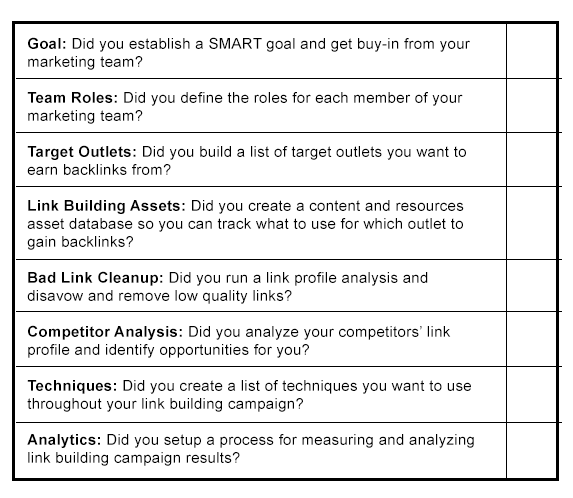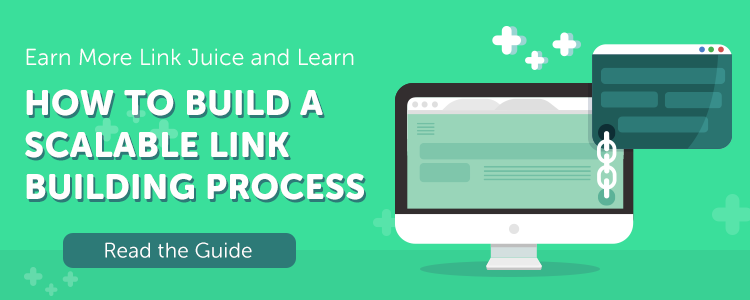Link building is essential to every digital marketing team.
If you want to climb search engine results pages (SERPs) and gain authority in your space, you need to actively seek out links. You can't simply sit back and wait for people to find your awesome content.
Your best bet for actively seeking out and earning backlinks is conducting a link building campaign.
Link Building Campaign
Before you dive into executing your first link building campaign, you need to brush up on the basics.
Let's look at what makes a link building campaign successful, what types of links you want to pursue, what techniques to try, and how to use a checklist to make sure you build a campaign the right way.
What Is a Link Building Campaign?
A link building campaign is your approach to start earning backlinks to your website in a proactive manner. Your campaign might be a months-long process or just a few weeks of executing link building tactics.
Regardless of how big your campaign, it will include the following components:
Goals
As with every marketing initiative, you need to set SMART goals. But don’t simply set out with a simple objective, like “earn five backlinks in two weeks.”
This is not nearly detailed enough. Focus on fleshing it out more.
What are the bigger impacts these backlinks have on your entire organization? How will you achieve this goal? How are you going to measure your progress?
A truly impactful SMART goal for your link building campaign is clearly aligned with a bigger marketing objective, and it involves a concise description of the link building tactics you’re using.
Here’s an example of a strong link building campaign goal:
“Within three months, our organic traffic will increase by 20 percent and our website will generate 50 backlinks from websites that have a domain authority over 35 through manual outreach, influencer engagement, guest blogging, and broken link building.”
Ah, that's way better!
Not only do you see the bigger impact of the link building (boosting organic traffic), but you also see the details that are easily overlooked (like targeting websites with a domain authority over 35) and get an idea of the tactics your team will be using (outreach, guest blogging, etc.)
Look, let’s face it – attributing business results to digital marketing efforts like link building tactics is not easy. This is why you need to educate stakeholders on the ripple effect building links has on your digital presence.
For example, adding valuable links boosts authority-specific SEO metrics, increases ranking potential, and adds more channels for referral traffic.
Show them your data to detail how tactics yield high quality inbound links, and summarize how these links are impacting other important metrics.
Content and Resources
Peers in your industry won’t simply link to your site for no reason. They need a strong enough “why” to link to you and deliver that “vote of confidence” that tells search engines and users alike that they view you as a strong authority.
Your content and resources are the assets you need in place to start generating interest from others. If your marketing team is delivering the informative, educational content, you can build an engaged audience.
And you can expand brand visibility and add to your audience by reaching out for links to your badass content and resources (more on this later).
Techniques and Tactics
Ok, so you set your goal and have an existing body of content and high value resources your audience enjoys. What’s next?
This is where you start taking action through several unique, strategic approaches. Your techniques and tactics make your link building goals a reality.
But your link building campaign should not just focus on quantity of links earned. You need to focus on quality of your backlinks.
The Good and the Bad: Types of Links
Not all links are created equal. In fact, some of your inbound links could hurt your website and diminish your domain authority.
Let’s review the good and bad types of links:
Bad Links to Avoid
The most common type of links that you want to prevent from earning is non-editorial links that you create. These are often associated with black hat SEO and won’t deliver any real SEO value.
Common examples of these kinds of links include:
- Shady link directories
- Blog comment spam
- Guest post signatures
- Advertorials
Your site likely has some bad backlinks, which you can remove to improve SEO performance. You can either manually reach out to the linking domains to request that they remove the link or disavow them using the Google Disavow Tool.
Good Links You Want to Earn
The best links you can generate are known as editorial links. These are earned naturally, meaning you don’t have to ask for them. For example, an industry thought leader might find your awesome blog post or recent pillar page and link to it in their content.
Outreach links are another high value target to aim for. These are backlinks you actively prospect for and request. For example, you email a link for that awesome blog post you just wrote to relevant influencers, requesting a backlink.
While the easiest link building comes from editorial links, these are rare. Your link building strategies will often consist of a variety of manual techniques.
10 Link Building Techniques to Try
These are your best approaches to take to fuel your campaign so you can hit your campaign’s goal.
1. Create Kickass Content.
This is a prerequisite for all link building. If your content is lackluster, you won’t earn backlinks. Make sure you’re using all kinds of formats for your content.
Visually appealing content is especially helpful because people love to share cool visual content like infographics.
2. Pursue Broken Link Building.
This is a simple five-step process for earning links from targeted domains.
- Create a list of sites you want links from.
- Use tools like Check My Links to find broken links on specific pages.
- Research the broken link to see what other sites are linking to the dead page, and add them to a list.
- Use the Wayback Machine to see what the broken link page included, then create new, improved content to replace the dead page.
- Finally, start outreach to the domains linking to the broken link and encourage them to link to your new content.
3. Build Influencer Relationships.
Reach out to influencers in your space to earn backlinks and even social shares. You can create deals so the share is mutually beneficial for you and the influencer.
4. Write Guest Posts.
Build a list of targeted sites to guest blog for and send them content to publish. Aside from earning a backlink from the site, you also get to share your expertise with a wider audience and boost visibility for your business.
5. Get Social on the Right Platforms.
The obvious platforms are Facebook, LinkedIn, and Twitter, but don’t overlook other lesser known communities, like Reddit and Quora.
6. Start Monitoring Mentions.
Set up mention alerts. Sometimes, people might be mentioning your name and your company but failing to link to your site. Simply, reach out and ask for a backlink when you’re mentioned.
7. Consider Content Syndication.
Seek out relevant opportunities with industry-specific outlets and try to agree on them republishing your content.
When you're looking to get republished elsewhere, keep these tips in mind:
- Ensure the rel=canonical tag is added.
- Add a nofollow tag.
- Publish on your site first and ensure it gets indexed before trying to get it syndicated.
8. Use Competitor Backlink Analysis.
Run reports with SEO tools, like Moz and Ahrefs. By looking at your competitors' link profiles, you can see where they're earning links from. Then, you can try to follow suit and reach out to those linking domains.
9. Earn Testimonials.
Ask customers for reviews and testimonials. These quick-win pieces of content tell search engines to crawl more pages on your site, which can boost your ranking potential.
Those happy customers might even share their reviews and testimonials to their followers.
10. Pursue In-Person Community Engagement.
Even in the world of digital marketing, in-person engagement is very valuable. Consider hosting events, seeking speaking engagements, volunteering at local charities, and the like.
Fellow participants and brands involved might mention you in their content after the event.
With all these techniques and components in mind, you're ready to get started on your first campaign.
Your Link Building Campaign Checklist
Your first link building campaign is an excellent opportunity to get your entire link profile up to speed.
Here’s a checklist to use to get your campaign up and running:

Now, you’re ready to start building high value links to your site. What are you waiting for?


Jeff Previte
I am a Content Manager at Bluleadz. I enjoy spending time outdoors -- camping, hiking, hammocking, and everything in between. I also love reading, writing, and learning how to play guitar.